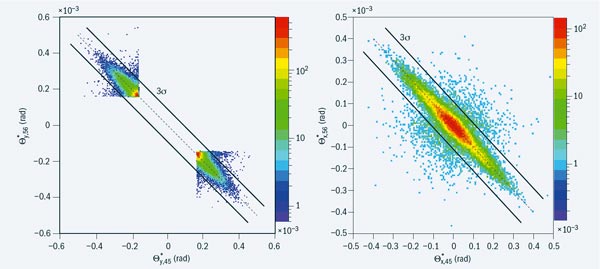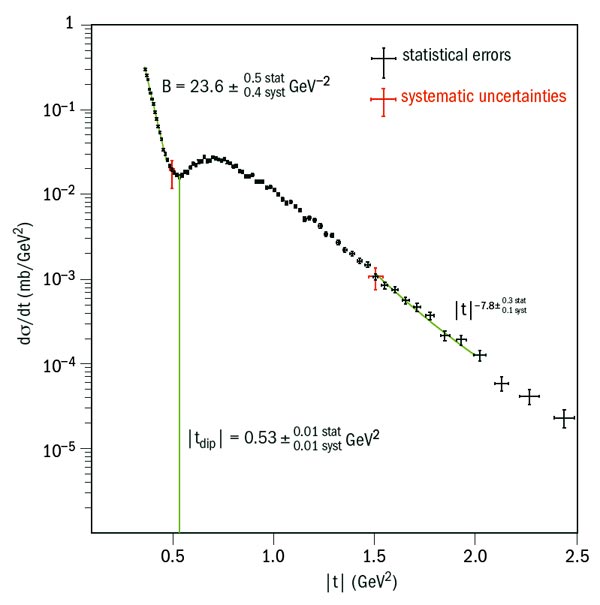Finding out more about the proton at LHC energies.

Forty years ago, the Intersecting Storage Rings (ISR) at CERN became the world’s first proton–proton collider, transporting the study of particle physics to much higher energies than was otherwise achievable. Now, the same is happening again at CERN as the LHC begins to open up a new high-energy frontier and it is interesting to find out how phenomena discovered at the ISR develop as the collision energy increases.
One of the first discoveries at the ISR was that the total proton–proton (pp) cross-section rises with energy: rather surprisingly, the proton becomes both larger and more opaque. Later, measurements of pp elastic scattering showed further unusual behaviour, revealing a peculiar structure in the variation of the differential cross-section with t, the four-momentum transfer squared. Now, the TOTEM collaboration at the LHC has published its first results on pp elastic scattering, which confirm that the behaviour observed at the ISR continues towards much higher energies.
The differential cross-section measured at the ISR showed a sharp peak at small values of |t| = (0.01–0.5) GeV2 that falls away exponentially to a dip, at about 1.4 GeV2, followed by a broad local maximum that eventually decreases more or less as |t|–8 (figure 1a). Measurements at different centre-of-mass energies in the range 23–62 GeV revealed that the sharp peak at low |t| appears to become narrower (“shrinks”) with rising energies, with the dip moving towards smaller values of |t|, indicating that the radius of the proton (rp2 ˜ 1 / |t|) is, in effect, increasing with energy. However, the power-law dependence at larger |t| values appeared not to depend on energy.
The ISR was also the world’s first proton–antiproton (pp) collider and measurements there showed a similar behaviour for the elastic differential cross-section (figure 1b), but without the pronounced dip, which was replaced instead by a broad “shoulder”. Between the ISR and the start-up of the LHC, the only measurement of pp elastic scattering was performed by the pp2pp experiment at Brookhaven’s Relativistic Heavy Ion Collider at 200 GeV in the centre-of mass over a limited |t| range around 10–2 GeV2. For pp, on the other hand, higher collision energies became available in the 1980s; first at CERN’s Super Proton Synchrotron (546 GeV) and then at Fermilab’s Tevatron (up to 1.96 TeV). Measurements at these energies showed that the pp cross-section continued to exhibit a similar shape as at the ISR, but without a pronounced dip as observed in pp scattering.

The LHC now presents the first opportunity to follow the behaviour observed at the ISR for pp scattering to higher energies, in particular with the experiment TOTEM, which stands for “TOTal cross-section, Elastic scattering and diffraction dissociation Measurement”. TOTEM is optimized for measuring elastic pp scattering over values of |t| ultimately in the range 0.001–10 GeV2. It can detect protons scattered at small angles by using silicon detectors in Roman Pots – movable insertions in the beam pipe that allow the detectors to be brought close to the beam. The experiment is located at point 5 on the LHC (together with CMS) and there are Roman Pot stations at distances of 147–149 m and 215–220 m from the interaction point. Each station contains two units that are 2–5 m apart and each consists of two pots in the vertical plane, which approach the beam from above and below, and one pot that moves horizontally. Each pot contains a stack of 10 specially designed silicon-strip detectors that have an insensitive region facing the beam of only a few tens of micrometres.
There are 512 strips per detector with 66 μm spacing and the detectors are oriented such that five of the 10 planes per pot are at +45° with respect to the edge near the beam, while the other five are at –45°. The trigger requires collinear hits in at least three of the five planes in each projection. This is implemented by programmable coincidence logic in integrated circuits that are mounted on the detectors and must therefore be radiation tolerant. Elastic candidate events require two reconstructed collinear diagonal tracks.
In a dedicated run of the LHC in October 2010, with only four proton bunches of 7 × 1010 protons per bunch, the TOTEM experiment acquired data for a total integrated luminosity of 6.1 nb–1 at a centre-of-mass energy of 7 TeV. The low-luminosity configuration of the LHC allowed the detectors to be brought in towards the centre of the beam to a distance of only seven times the 1σ width of the beam itself. The collaboration has analysed these data and in July published the first results on elastic pp scattering in the new high-energy region of the LHC.

The figure on the front cover of this month’s CERN Courier shows the histogram of the intersection points of the selected tracks in this data set with the Roman-pot silicon detectors at 220 m from the interaction point. The tracks are indicated in the bottom silicon detectors at one side and in the top detectors at the other side of the interaction point, representing the pp scattering configuration; the coloured scale shows the number of tracks on a log scale, from less than 10 in the dark blue to more than 10,000 in the red. The displacement in the vertical direction (less than 2 mm for the red region) is to a first approximation proportional to the vertical scattering angle. With the current LHC beam optics the horizontal scattering angle leads to only a small displacement in the x direction. However, protons that have lost momentum are shifted in the +x direction by the dispersion of the machine. This means that elastically scattered protons remain close to x=0, while those that are diffractively scattered are displaced in the positive x direction (the green region). Already in the raw data, the accumulation of elastic events close to x=0 and near the edge of the detectors is clearly distinguishable from the background mainly from diffractive events. Thus |x| <0.4 mm is the first criterion for selecting elastic candidates.
Vertical and horizontal scattering angles can be deduced from measurements of the track displacement in y and the track angle in x at the Roman pot stations. For collinear tracks on either side of the interaction point, these angles should be the same – as is impressively demonstrated in figure 2. Collinearity cuts at 3σ, as shown in the figure, provide another powerful tool to reduce background further.
From a total of 5.28 × 106 recorded triggers, 293 × 103 events had the required constructed tracks and elastic topology, of which 70.2 × 103 passed the cut in |x| and 66.0 × 103 survived the final collinearity cuts. These events were then used to calculate the differential cross-section, the value of |t| being derived from the measured scattering angle.

Figure 3 shows the differential cross-section that TOTEM has measured for elastic pp scattering in the |t| range 0.36 < |t| < 2.5 GeV2. It clearly exhibits the global features that were first seen at the ISR. At |t| < 0.47 GeV2 the data show an exponential decrease with a peak at low |t| sharpening with energy and leading to a well pronounced diffractive minimum at |t| = (0.53±0.01 stat.±0.01 syst.) GeV2, followed by a rounded peak that falls away as a power law, |t|–n, where n = 7.8 ±0.3 stat. ±0.1 syst. In particular, the data confirm the trend first observed at the ISR that the dip moves towards smaller values of |t| with increasing collision energy. At the ISR the dip appeared at a value of |t| around 1.4 GeV2; now, at a centre-of-mass energy of 7 TeV – some 100 times higher – TOTEM has found the dip to be near 0.5 GeV2. Interpreting this within the optical model, the proton continues to become larger with energy and consequently the total cross-section should rise further.

These first measurements of elastic scattering at LHC energies already begin to differentiate between various models. As figure 4 shows the position of the dip and the slopes at smaller and larger |t| agree with the predictions of some models but not with others. However, none of these models is capable of correctly predicting the measured size of the cross-section over the total |t| -range.
For the TOTEM collaboration this marks just the beginning. The experiment has already accumulated 5.8 pb–1 of data in high-luminosity runs that will extend the range in |t| to 4–5 GeV2. Special LHC beam optics for dedicated runs are presently being commissioned to reach much smaller |t| values down to below 0.01 GeV2. This will allow a better extrapolation of the differential cross-section to t = 0. A measurement of the total pp cross-section with a luminosity-independent method based on the optical theorem will then be possible for the first time in this new high-energy region. The TOTEM collaboration is confident that this data taking will start soon and that first results will be available around the end of 2011. Furthermore, diffractive phenomena are on the list of investigations. There is much to look forward to – in more ways than one.





